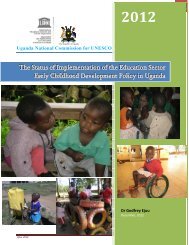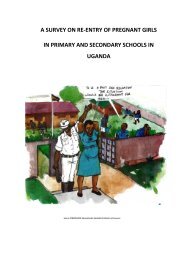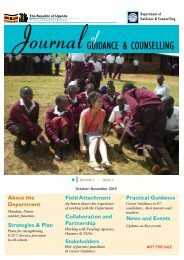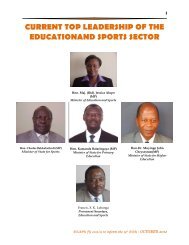Download Pdf - Ministry of Education and Sports
Download Pdf - Ministry of Education and Sports
Download Pdf - Ministry of Education and Sports
You also want an ePaper? Increase the reach of your titles
YUMPU automatically turns print PDFs into web optimized ePapers that Google loves.
Meetings were held where it was agreed that a survey on reentry <strong>of</strong> pregnant girls in primary <strong>and</strong><br />
secondary schools in Ug<strong>and</strong>a be conducted first to inform the formulation <strong>of</strong> guidelines. Consultants<br />
to conduct the study were procured <strong>and</strong> ToR developed;<br />
A study on teenage Pregnancies was carried out by FAWE <strong>and</strong> a Gender Task Force workshop<br />
conducted in November 2011 to present the draft study report <strong>and</strong> seek input <strong>of</strong> other stake holders.<br />
The sub sector undertook a UN advocacy campaign in western Ug<strong>and</strong>a (Mbarara, Kisoro, <strong>and</strong> Kabale)<br />
in July, August <strong>and</strong> September, 2011.<br />
The sub sector continued to Train care givers <strong>and</strong> proprietors <strong>of</strong> ECD centers in 3 sub counties <strong>of</strong><br />
Kyotera, Matale, <strong>and</strong> Sanje in Rakai district.<br />
61<br />
(v)<br />
Implementation <strong>of</strong> the curriculum<br />
In FY 2011/12, NCDC embarked on a number <strong>of</strong> activities to improve the quality <strong>of</strong> preprimary <strong>and</strong><br />
primary education. These included; holding Cluster meetings with teachers in 8 poorly performing<br />
districts;<br />
Monitoring implementation <strong>of</strong>; thematic curriculum in P.1, P.2 <strong>and</strong> P.3; <strong>and</strong> P.6 curriculum in schools;<br />
Printing <strong>and</strong> distribution <strong>of</strong> 100,000 copies <strong>of</strong> the curricula; orienting 45,724 P.7 classroom teachers<br />
nationwide; printing <strong>and</strong> distributing 25,000 copies <strong>of</strong> the implementation guidelines; sensitization<br />
<strong>and</strong> formation <strong>of</strong> 13 area language boards in 23 districts; <strong>and</strong>,<br />
Retooling <strong>of</strong> 127 teachers on term 1 <strong>and</strong> term 2 P.5 Kiswahili syllabus.<br />
(d)<br />
Outcomes/Results.<br />
(1) Pre‐primary<br />
Preprimary schooling (ECD) is a process by which children grow <strong>and</strong> thrive, physically, socially,<br />
emotionally, <strong>and</strong> cognitively. ECD is considered to be the most critical foundation stage <strong>of</strong> growth<br />
<strong>and</strong> development. Both the World Declaration on <strong>Education</strong> For All (Jomtien, 1990) <strong>and</strong> the Dakar<br />
Framework for Action (2000) to which Ug<strong>and</strong>a is signatory, underscore the importance <strong>of</strong> Early<br />
Childhood Care <strong>and</strong> <strong>Education</strong> (ECCE) as part <strong>of</strong> a comprehensive approach to achieving <strong>Education</strong><br />
For All (EFA).<br />
(i)<br />
Pupil Classroom Ratio in PrePrimary Schools<br />
The number <strong>of</strong> pupils per class is key in determining the effectiveness <strong>and</strong> efficiency <strong>of</strong> learning <strong>and</strong><br />
teaching in preschools. Classes with fewer pupils are easy to manage <strong>and</strong> monitor as compared to<br />
classes with large numbers <strong>of</strong> pupils. Figure 4.5 below shows the Pupil Classroom Ratio in Preschool<br />
during FY 2010/11 <strong>and</strong> 2011/12.<br />
ESSAPR FY 2011/12 to inform the 19 th ESSR – OCTOBER 2012








